精选2019-2020年牛津译林版初中七年级上英语预备课程Lesson 1 Nice to meet you !课后练习第十四篇
- 格式:docx
- 大小:552.51 KB
- 文档页数:8
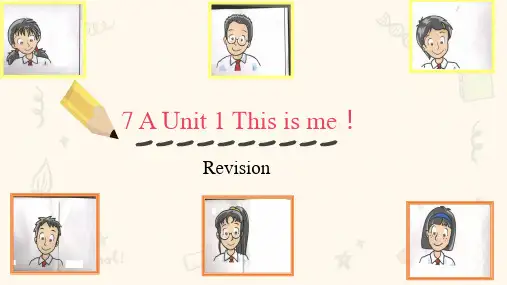
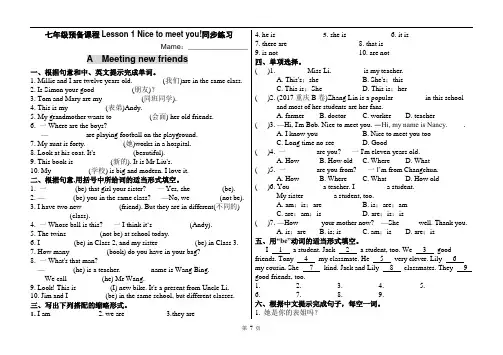
七年级预备课程Lesson 1 Nice to meet you!同步练习Mame:_______________A Meeting new friends一、根据句意和中、英文提示完成单词。
1. Millie and I are twelve years old. ________(我们)are in the same class.2. Is Simon your good __________(朋友)?3. Tom and Mary are my __________ (同班同学).4. This is my __________ (表弟)Andy.5. My grandmother wants to __________(会面) her old friends.6. 一Where are the boys?—__________ are playing football on the playground.7. My aunt is forty. __________(她)works in a hospital.8. Look at his coat. It's __________(beautiful).9. This book is __________(新的). It is Mr Liu's.10. My __________(学校) is big and modern. I love it.二、根据句意,用括号中所给词的适当形式填空。
1. 一________(be) that girl your sister? 一Yes, she ________ (be).2. —________(be) you in the same class? —No, we ________(not be).3. I have two new __________(friend). But they are in different(不同的) _________(class).4. 一Whose ball is this? 一I think it‘s __________(Andy).5. The twins _________(not be) at school today.6. I _________(be) in Class 2, and my sister __________(be) in Class 3.7. How many __________(book) do you have in your bag?8. 一What's that man?—________(he) is a teacher. ________name is Wang Bing.We call _________ (he) Mr Wang.9. Look! This is _________(I) new bike. It's a present from Uncle Li.10. Jim and I _________ (be) in the same school, but different classes.三、写出下列搭配的缩略形式。
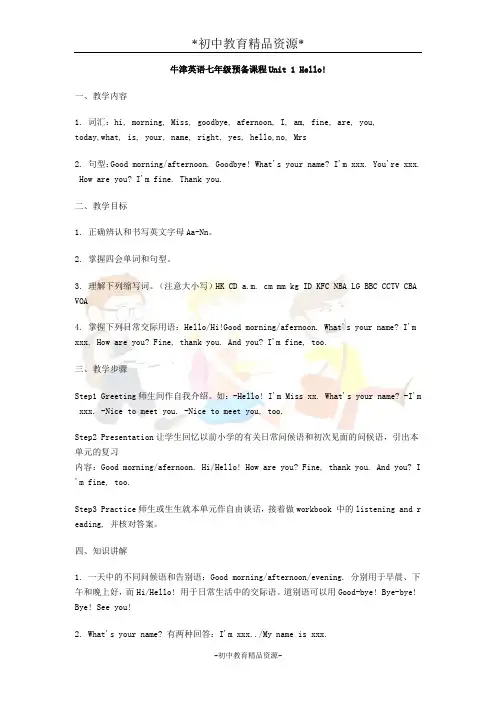
牛津英语七年级预备课程Unit 1 Hello!一、教学内容1. 词汇:hi, morning, Miss, goodbye, afernoon, I, am, fine, are, you,today,what, is, your, name, right, yes, hello,no, Mrs2. 句型:Good morning/afternoon. Goodbye! What's your name? I'm xxx. You're xxx. How are you? I'm fine. Thank you.二、教学目标1. 正确辨认和书写英文字母Aa-Nn。
2. 掌握四会单词和句型。
3. 理解下列缩写词。
(注意大小写)HK CD a.m. cm mm kg ID KFC NBA LG BBC CCTV CBA VOA4. 掌握下列日常交际用语:Hello/Hi!Good morning/afernoon. What's your name? I'm xxx. How are you? Fine, thank you. And you? I'm fine, too.三、教学步骤Step1 Greeting师生间作自我介绍。
如:-Hello! I'm Miss xx. What's your name? -I'm xxx. -Nice to meet you. -Nice to meet you, too.Step2 Presentation让学生回忆以前小学的有关日常问候语和初次见面的问候语,引出本单元的复习内容:Good morning/afernoon. Hi/Hello! How are you? Fine, thank you. And you? I 'm fine, too.Step3 Practice师生或生生就本单元作自由谈话,接着做workbook 中的listening and r eading, 并核对答案。
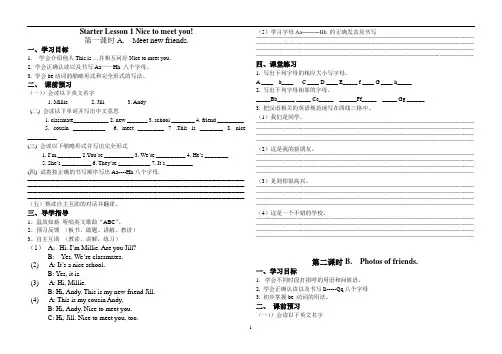
Starter Lesson 1 Nice to meet you!第一课时A. Meet new friends.一、学习目标1.学会介绍他人This is …并相互问好Nice to meet you。
2. 学会正确认读以及书写Aa——Hh 八个字母。
3. 学会be动词的缩略形式和完全形式的写法。
二、课前预习(一))会读以下英文名字1. Millie2. Jill3. Andy(二) 会读以下单词并写出中文意思1. classmate____________2. new _______3. school ________4. friend _________5. cousin ___________6. meet _________ 7 .This is ________ 8. nice __________(三) 会读以下缩略形式并写出完全形式1. I’m ________2.You’re __________3. We’re __________4. He’s ________5. She’s __________6. They’re ___________7. It’s _________(四) 试着按正确的书写顺序写出Aa----Hh八个字母._____________________________________________________________________________________ _____________________________________________________________________________________ _____________________________________________________________________________________ _____________________________________________________________________________________ (五)熟读自主互助的对话并翻译。
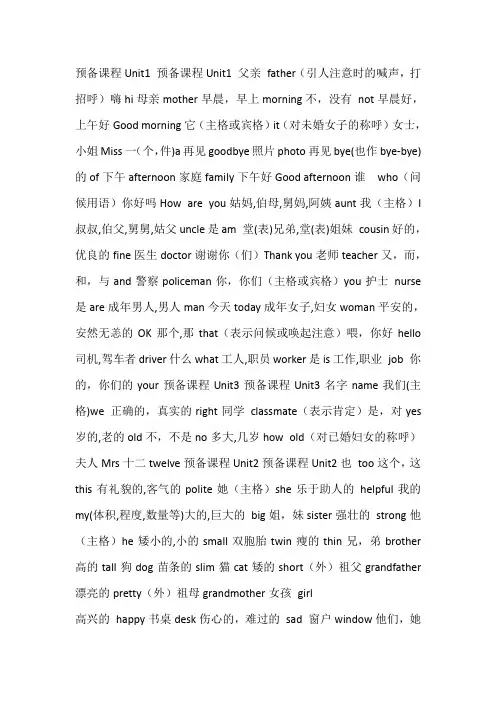
预备课程Unit1 预备课程Unit1 父亲father(引人注意时的喊声,打招呼)嗨hi母亲mother早晨,早上morning不,没有not早晨好,上午好Good morning它(主格或宾格)it(对未婚女子的称呼)女士,小姐Miss一(个,件)a再见goodbye照片photo再见bye(也作bye-bye)的of下午afternoon家庭family下午好Good afternoon谁who(问候用语)你好吗How are you姑妈,伯母,舅妈,阿姨aunt我(主格)I 叔叔,伯父,舅舅,姑父uncle是am 堂(表)兄弟,堂(表)姐妹cousin好的,优良的fine医生doctor谢谢你(们)Thank you老师teacher又,而,和,与and警察policeman你,你们(主格或宾格)you护士nurse 是are成年男人,男人man今天today成年女子,妇女woman平安的,安然无恙的OK那个,那that(表示问候或唤起注意)喂,你好hello 司机,驾车者driver什么what工人,职员worker是is工作,职业job 你的,你们的your预备课程Unit3预备课程Unit3名字name我们(主格)we 正确的,真实的right同学classmate(表示肯定)是,对yes 岁的,老的old不,不是no多大,几岁how old(对已婚妇女的称呼)夫人Mrs十二twelve预备课程Unit2预备课程Unit2也too这个,这this有礼貌的,客气的polite她(主格)she乐于助人的helpful我的my(体积,程度,数量等)大的,巨大的big姐,妹sister强壮的strong他(主格)he矮小的,小的small双胞胎twin瘦的thin兄,弟brother 高的tall狗dog苗条的slim猫cat矮的short(外)祖父grandfather 漂亮的pretty(外)祖母grandmother女孩girl高兴的happy书桌desk伤心的,难过的sad 窗户window他们,她们,它们(主格)they包bag妈妈mum书book 有,拥有have铅笔盒pencil box二two使干净,打扫,清扫clean新的new一one朋友friend三three男孩boy五five从,来自from钢笔pen英格兰,英国England六six英国的,英格兰人的English尺ruler美国America七seven 美国的,美国人的American八eight这里here九nine允许,让let 铅笔pencil我(宾格)me十ten看一看have a look去,走go哦oh 向,朝,往to 好的good学校,学业,学校教育school他们的,她们的,它们的their上学去go to school(构成否定句及疑问句的助动词,无意义)do迟的late知道,了解know是be(表示了解或发现某事物的喜悦)啊哈aha是(现在式)am are is看look at又,再次again他们,她们,它们(宾格)them在之内in四four班级class全部,都all十六sixteen中国人,中国的Chinese十四fourteen预备课程Unit4预备课程Unit4看,看上去(vi) look打开open教室classroom (定冠词)这,这些the(作引导词)表示“存在”there门door在之上on请please墙wall关,关闭close十一eleven站stand数字,号码number站起来,起立stand up号码缩略式No.坐sit十五fifteen 坐下sit down十八eighteen黑板blackboard橡皮rubber十七seventeen当然of course 十三thirteen(口)美妙的,极好的great在后面behind学习study椅子chair 预备课程Unit6预备课程Unit6讲台teacher,s desk公园park十九nineteen在之间between盒子box小山hill图画,照片picture在旁边beside海报,招贴画poster 商店shop球ball在下面under二十twenty在前面in front of学生student大门gate(元音前)一(个,件...)an鸟bird美术art 花flower 室,房间room湖lake干净的clean树tree三十thirty 爬climb预备课程Unit5预备课程Unit5游泳swim电脑computer 摘pick足球场football field喂feed多少how many哪里where建筑物,大楼building 很,非常,十分very办公室office开着的open洗手间toilet左面(的)left图书馆library右面(的)right操场,游乐场playground能,可以can礼堂hall看see仅仅,只有only(用于感叹句中)多么,何等how 百hundred可爱的,好看的lovely美丽的,漂亮的beautiful在中间in the middle of花园garden(复)儿童,小孩children楼层,地板floor (单)儿童,小孩child(英)第一层ground floor许多many(英)第二层first floor船boat任何的,任一的any来come一些,若干some 草,草坪grass阅览室reading room开始,起点start篮球场basketball court行走,散步walk餐厅dining hall错过一次机会miss a trun(答话时表示感兴趣或惊讶)真的really 回答answer。
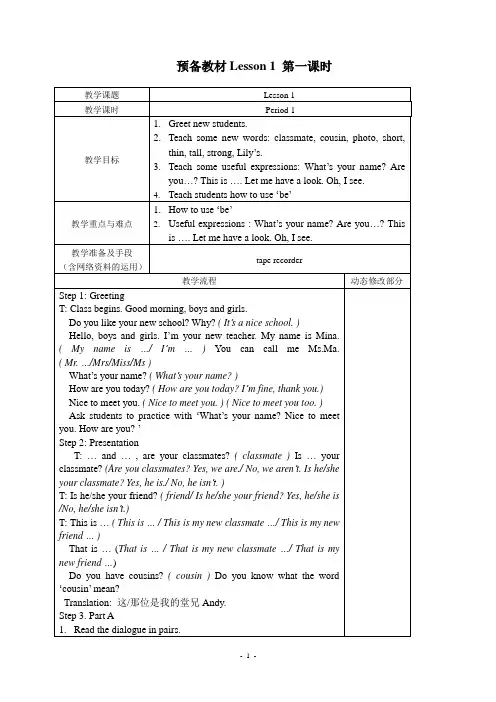
预备教材Lesson 1 第一课时预备教材Lesson 1 第二课时预备教材Lesson 2 第一课时预备教材Lesson 2 第二课时Lesson 3 A nice school Period 1Lesson 3 A nice school Period 2Lesson 4 You look cool! Period 1Lesson 4 You look cool! Period 2预备教材Lesson 5 第一课时预备教材Lesson 5 第二课时预备教材Lesson 6 第一课时预备教材Lesson 6 第二课时Lesson 7 Enjoy our days (PartA)教学目标1.To learn the subjects at school.2.To master how to talk about school days.3.To be able to introduce one’s week.重点To master how to talk about school days.难点To be able to introduce one’s week.教学准备Multi-media, tape recorder教学设计详案二次备课内容Step 1 Revision and lead-in1. T: Good morning, boys and girls. What day is today?Ss: Today is……T: How many days are there in a week? What are they?Ss: ……2.T: Every day, you have seven lessons at school. What s ubjectsdo you have today?S1:……T: How many English lessons do you have today?S2: ……T: How many Ch inese lessons do you have today?S3: ……T: What about Math/ Science/ PE?(通过真实情况,呈现主要课程的名称)Step 2 DiscussionT: Now let’s have a discussion about subjects in a week.Q1: What subjects do you have on Monday / Tuesday /Wednesday / Thursday / Friday?Q2: How many Chinese / Math / English / Art / Music / Science/ Computer / PE lessons do you have every week?2. Ask Ss to present their results.Step 3PresentationT: Look , this is an email. It’s from Nick to Tony. What day does Nick love? Why?T: Read the text and answer the questions.What subjects does Nick have every day?What subjects does Nick have on Monday and Wednesday? What about Tuesday and Thursday?T: Read the text and tell true or false.Nick gets up early in the morning every day.Nick walks to school every day.Nick’s classes begin at nine.Nick goes to school on Saturday aft ernoon.Nick wants Tony to write ba ck.(适时呈现get up, early, walk, at eight, go to school, etc.)T: Let Ss discuss about “What subjects do you like? Why? What day do they like i n a week?”After that, a sk Ss to present their report.Step 4 PracticeLet Ss read the text after the tap e and then complete the ta ble in Part A2.Step 4 Summary作业设计1.Learn the text by heart.2.Preview Part B.教学反思Lesson 7 Enjoy our days (PartB)教学目标1.To master the seasons and months of the year.2.To be able to use “in”, “on” and “at”correctly.重点To be ab le to master the seasons and months of the year.难点To be able to learn the differences between “in”, “on” and “at”.教学准备Multi-media教学设计详案[来源:学+科+网Z+X+X+K]二次备课内容Step 1 RevisionT: When do you get up in the morning?Ss:……T: When do you go to school?Ss: ……T: When do your classes begin?Ss: ……(鼓励学生简单介绍自己一周的学习和生活)Step 2 Presentation1.Show Ss a clock.2.T: Look at the clock. What time is it? It’s 9:30 at night. Mi llieoften goes to bed at 9:30 and has a good sleep. What aboutyou? When do you go to bed at night? Do you have a goodsleep?(呈现go to bed, at night 和have a good sleep)3. Present a picture of flying kites..T: What do you often do in spring? Do you like playing in theopen air? Do you like flying kites? (呈现in the open air和flykites)4. T: What do you often do on Saturday or Sunday? Do you go toschool? Do you get up early in the morning? How many days are there in a week? How many weeks are there in a month? How m any months are there in a year? How many seasons are there in a year? (呈现month、season、spring、summer 、autumn和winter.5. Tell Ss a year has 12 months and what they are. Let them t alk about things they can do in different months and seasons.Step 3 PracticeAsk Ss to make up dialogues in pairs using what they have learnt before and encourage them to act them out.Step 4 PresentationLet Ss listen and tell “T” or “F”.Millie often goes to bed at 9:00 in autumn. ( )The Chinese New Year is in January or February. ( )It is warm and windy in spring. ( )Students have a short holiday in summer. ( )Ask Ss to complete Part B2 and work out the rule.Let Ss read the text after the tape and then ask them to read Part B3 together.Step 5 PracticeLet Ss make a dialogue to talk about all kinds of festivalsStep 6 Summary作业设计1. Learn the passage by heart.2. Complete the exerci ses.教学反思Lesson 7 Enjoy our days (PartC, D)教学目标1. To enable Ss to talk about their activities in their everyday life.2. To be able to write a simple article of their week.重点To enable Ss to talk about their activities in their everyday life.难点To be able to write a simple article of their week.教学准备Multi-media教学设计详案二次备课内容Step 1 Revision and lead-inT: What time do you get up/ have breakfast/ go to school/ havelunch/ have dinner/ go to bed every day?Ss: …..T: What time does your mum/ dad cook dinner every day?Ss: …..T: What time do your classes begin every day?Ss: …..T: What time do you often……?(适时引出o’clock、half past等表达方式)Step 2 Presentation1. Show the Ss some photos, and ask the students somequestions.What do the boys often do after school? What does Ni ck doafter dinner? (呈现do sports、play basketball、do homework和inthe eve ning等)2. Listen and tell “T” or “F”.Nick gets up at six forty in the morning. ( )Nick often plays football at four o’clock in the aftern oon. ( )Nick often does his homework at half past five after dinner. ( )Nick often goes to bed at nine twenty in the evening.( )3. Ask Ss to read after the tape and then read t ogether and in roles.Step 3 Practice1. Ask students to finish a timetable according to their every day life. Let Ss make a dialogue and act it out.2. Ask: What do you often do at six o’clock in the morning? What do you often do at half past seven in the evening? (呈现go to work、come back、get home、cook dinner、wash clothes and watch TV等).3. T: When do your parents go to work every day? What time does your mother/ father get up in the morning? What time does your mother/ father cook dinner?4. Let Ss to complete Part D according to their own in formation. Step 4 Summary作业设计Write an article about your own busy week.教学反思Lesson 8 Let’s have fun! Period 1教学目标1. Learn some new words: sunny, great, plants and so on.2. Learn some useful expressions: go out, good idea, by bus/bike/car/plane, wait long, go boating on the lake and so on.3. Can express the traveling ways.Know the meaning of going out and having fun.重点Master new words and useful expressions.难点Can you make traveling plans.教学准备Multi-media教学设计详案二次备课内容Step 1 RevisionHave students work in pairs and make dialogues with ‘Whattime do you …?’Have students say something to describe his/her day.Step 2 Presentation1. T asks questions like:What do you often do on Saturday?Do you want to go out to have fun? ( go out, have fun ) Where doyou want to go? ( go to the cinema, go to the park )What do you want to do there? ( see a film, go boating on thelake )How do you get there? ( get there, by bus/bike/plane/taxi, onfoot )Do you know how I like going there? ( see plants and trees onmy way, The streets are busy, I need to wait long. )2. Finish Part A, Workbook.Step 3 Part AAsk students to read the dialogue by themselves.Ask one to read it for others.Have students answer questions like:Where does Peter want to go? How does he get there? Where does Sally want to go? How does she get there? Ask students to finish Part A2.Read the dialogue after T.Real play reading.Step 4 ConclusionStep 5 HomeworkRecite the dialogue.Remember the new words and phrases.作业设计Write an article about your own busy week. 教学反思Lesson 8 Let’s have fun! Period 2教学目标1. Learn some new words: farm, cow, horse, sheep, beside, under and so on.2. Learn some useful expressions: It takes some time to do sth, swim in the river and so on.3. Can use prepositions to express directions correctly.重点New words and phrases.难点The use of prepositions of place.教学准备Multi-media教学设计详案二次备课内容Step 1 RevisionT: Do you want to go out? Where do you want to go? (Is it faraway from your home/our city?) How do you go there?Ask two pairs to recite the dialogue in Part A1.Step 2 PresentationShow the picture in Part B1. Look at the boy. He’s on a farm.What can you see on the farm? ( cow, horse, grass, house, duck,river ).Where are the cows, horses and sheep? ( on the grass )Where is the big tree? ( beside the house )Where is the dog? ( under the tree)Where are the ducks? ( behind the tree)Where is the river? ( near the house , swim in the river )Where is the boy? ( in front of the house )Where are the birds? ( in the tree)Where is the tree? ( on the left of the house )Where are the animals? ( on the right of the house)Where are the horses? ( between the cows and the sheep )Ask students to make dialogues with those prepositions with the help of things in the classroom.Where is/are …? It’s/They’re …Step 3 Part BAsk students to read the text by themselves.Ask one to read it for others.Ask one student to be a reporter and ask questions like:Where do you often go in summer?Where’s the farm?How do you get there?What’s on the farm?What do you do on the farm?Read the text after T, and then read it together.Finish Part B2.Have students to read dialogues in Part B3.Finish Part B3, Workbook.Step 4 ConclusionStep 5 HomeworkAsk students to recite the text.作业设计Write an article about your own busy week.教学反思Lesson 8 Let’s have fun! Period 3教学目标1. Practice oral English to talk about a trip.2. Writing about a trip.重点Talk about a trip.难点Writing about a trip.教学准备Multi-media教学设计详案二次备课内容Step 1 Revision.1.Ask two students to recite the text in Part B1.2.T asks several questions, students have to answer the questionswith ‘in/on/beside/under/behind/near/in front of/ on theleft/right of /between…and…’.Step 2 Presentation1.T: Where do you want to go this Saturday?How do you get there?What can you do there? (can see, learn about )2.Ask students to make dialogues like that.Step 3 Part C1.Ask students to read dialogues in Part C and answer questionslike:Where does Millie want to go this Saturday?What can you see in a zoo?Where does Nick want to visit this Sunday?What can he learn there?2.Ask two pairs to read the dialogues.3.Role-play reading.Step 4 Part D1.T: Where do you want to go? Where is the place? How can youget there? What can you do there? Please write down your ideas.2.Ask students to finish the writing in Part D, and then have twoto read it out.3.Finish Part D, Workbook.Step 5 ConclusionStep 6 Homework1.Go on practice dialogues with ‘where/how/what’.Recite the words in Lesson 8 for a dictation.作业设计Write an article about your own busy week.教学反思。
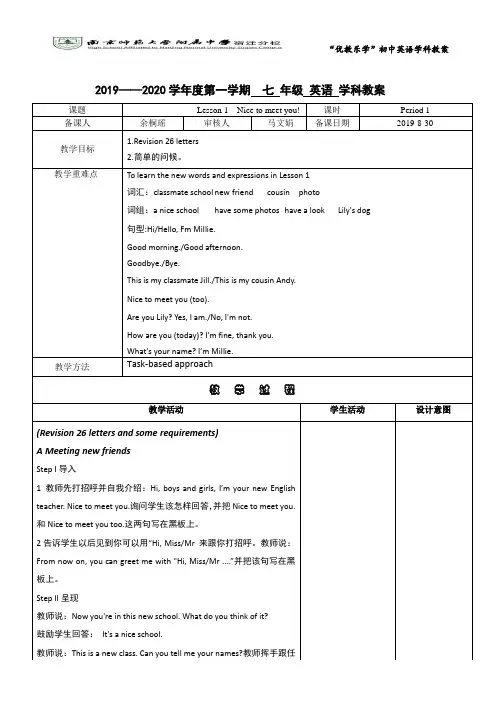
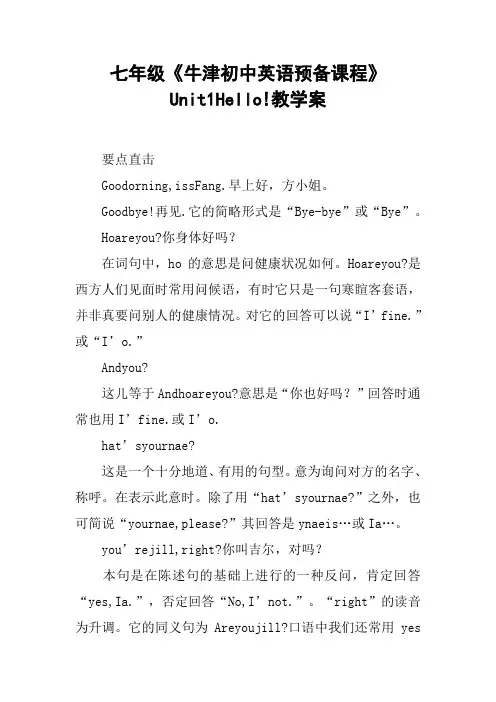
七年级《牛津初中英语预备课程》Unit1Hello!教学案要点直击Goodorning,issFang.早上好,方小姐。
Goodbye!再见.它的简略形式是“Bye-bye”或“Bye”。
Hoareyou?你身体好吗?在词句中,ho的意思是问健康状况如何。
Hoareyou?是西方人们见面时常用问候语,有时它只是一句寒睻客套语,并非真要问别人的健康情况。
对它的回答可以说“I’fine.”或“I’o.”Andyou?这儿等于Andhoareyou?意思是“你也好吗?”回答时通常也用I’fine.或I’o.hat’syournae?这是一个十分地道、有用的句型。
意为询问对方的名字、称呼。
在表示此意时。
除了用“hat’syournae?”之外,也可简说“yournae,please?”其回答是ynaeis…或Ia…。
you’rejill,right?你叫吉尔,对吗?本句是在陈述句的基础上进行的一种反问,肯定回答“yes,Ia.”,否定回答“No,I’not.”。
“right”的读音为升调。
它的同义句为Areyoujill?口语中我们还常用yes代替right。
如:“you’rejill,yes?”。
缩写形式I’是Ia的缩写形式;Ia是I’的完全形式。
hat’s是hatis的缩写形式;hatis是hat’s的完全形式。
you’re是youare的缩写形式;youare是you’re的完全形式。
Hello!你好!Hello通常用于以下四种情况:打招呼、打电话,表示惊讶或引起对方的注意。
意为“喂”、“你好”等。
Hello 等于hi,多用于非正式场合。
hi比hello使用时更随便,在美国青年人中使用更为普遍。
但是学生见到老师打招呼一般不说Hello,而应该说Goodorning!或Hoareyou?以免被认为不够礼貌。
0.有关字母的大小写句子开头个字母要大写。
人称代词单数主格I在句中任何位置都要大写。
例如:HeandIarestudents.他和我是学生。

牛津译林版七年级英语上册Unit 1 This is me!Ⅰ. 基础词汇名词(n.)1. 年,岁year2. 套房flat3. 数学maths4. 篮球basketball5. 俱乐部club6. 音乐music7. (复数)眼镜glasses 8. 鱼,鱼肉fish 9. 散步walk10. 牛奶milk 11. 祖父(母) grandparents 12. 世界world13. 周末weekend 14. 小时hour 15. 正餐,宴会dinner 16. 运动员player 17. 月份month 18. 橡皮rubber动词(v.)1. 穿,戴wear2. 游泳swim3. 希望hope4. 跑步run5. 借用borrow6. 说,讲say7. 开始start / begin形容词(adj.)1. 困难的hard2. 短的short3. 有礼貌的polite4. 乐于助人的helpful5. 长的long6. 每一个的every7. 下一个的next 8. 身体好的well 9. 强壮的strong10. 深色的dark 11. 好极的;使人快乐的great副词(adv.)1. 努力地hard2. 总是always3. 经常,通常usually4. 然后,那么then5. 有时sometimes6. 经常often7. 又,再again介词(prep.)在……之后after连词(conj.)当……时候when【典型例题】[例1]Liu Xiang looks ____________ (强壮的).答案:strong[例2]Sandy and Millie are _____________ (成员)of the Singing Club.答案:members[例3]This idea ___________ (听起来) great.答案:sounds[例4]Tom _______ (经常) returns home early but this evening he came back late.答案:usually[例5]The dress is _________ (real) expensive I cannot buy it.答案:really[例6]There are some ________ (鱼) in the pool in our school.答案:fish[例7]Sue wants to be a good ________ (run) in the future. She goes ____________ (run) every day.答案:runner, running[例8]My father _________ (watch) news on CCTV-1 every evening.答案:watches[例9]Shao Jiayi is a good football _________ (play). He is good at ___________(play) football.答案:player, playing[例10]Simon comes from China. He is polite and h__________.答案:helpful[例11]On Sundays, my father often goes f_________ in the river nearby(附近的)答案:fishing[例12]People in the world enjoy Beethoven’s (贝多芬) m_____ very much.答案:musicⅡ. 重点词组1. look after/take care of 照顾,照看2. live in a flat 住在公寓里3. be good/clever at sth./doing 擅长做……4. in the Reading Club 在读书兴趣小组5. come from 来自……6. be born 出生7. listen to music 听音乐8. work hard 努力学习9. wear short hair 留着短发10. wear glasses 戴眼镜11. enjoy/like/love doing 喜爱做……12. play computer games 玩电脑游戏13. have breakfast/lunch/supper 吃早饭/中饭/晚饭14. love sb. very much 非常喜欢某人15. talk to sb. 和某人讲话16. take sb. for a walk 带某人散步17. walk home 走回家18. take the bus 乘公共汽车19. like watching TV 喜欢看电视20. the best in the world 世界上最好的21. go running 去跑步22. have dinner 吃饭23. want to do/be 想要……24. the answer to… ……的答案25. borrow sth. from sb. 向某人借某物lend sth. to sb. 借给某人某物【典型例题】一、选择正确的词组填空使短文内容完整。
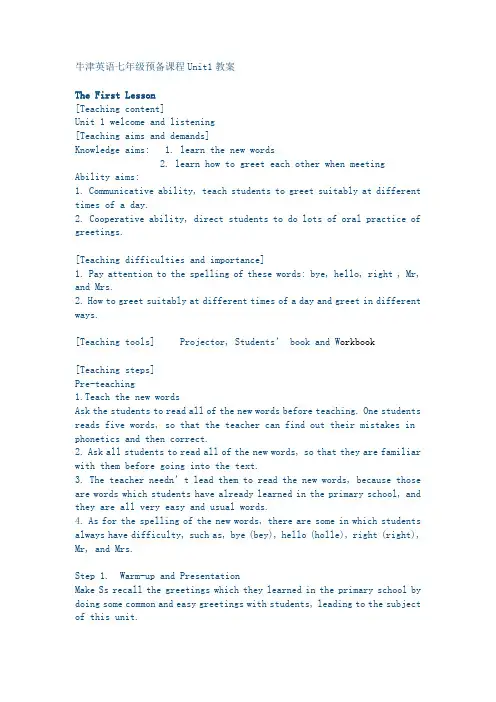
牛津英语七年级预备课程Unit1教案The First Lesson[Teaching content]Unit 1 welcome and listening[Teaching aims and demands]Knowledge aims: 1. learn the new words2. learn how to greet each other when meetingAbility aims:1. Communicative ability, teach students to greet suitably at different times of a day.2. Cooperative ability, direct students to do lots of oral practice of greetings.[Teaching difficulties and importance]1. Pay attention to the spelling of these words: bye, hello, right , Mr, and Mrs.2. How to greet suitably at different times of a day and greet in different ways.[Teaching tools] Projector, Students’ book and W orkbook[Teaching steps]Pre-teaching1.Teach the new wordsAsk the students to read all of the new words before teaching. One students reads five words, so that the teacher can find out their mistakes in phonetics and then correct.2. Ask all students to read all of the new words, so that they are familiar with them before going into the text.3. The teacher needn’t lead them to read the new words, because those are words which students have already learned in the primary school, and they are all very easy and usual words.4. As for the spelling of the new words, there are some in which students always have difficulty, such as, bye (bey), hello (holle), right (right), Mr, and Mrs.Step 1. Warm-up and PresentationMake Ss recall the greetings which they learned in the primary school by doing some common and easy greetings with students, leading to the subject of this unit.Step 2. Welcome to this unit1.Ask students to read the four dialogues of this part for twice, and get ready for the following questions to check if the students understand the meaning of the dialogues:Who is Andy? Who is Millie? Who is Lily? Who is Nick? Who is Miss Fang? When they meet,what do they say? When they meet in the morning, what do they say? When they part(分别), what do they say?2.Teach students some similar words and similar sentences of the four dialogues, and at the same time ask them to replace all of the names in the dialogues with the thoses of their classmates. Therefore, students can make another four dialogues of their own and of different patterns but of the same meaning.For example, Hi= Hello, Good morning= Good morning to you,Good bye= Bye-bye, Bye, See you, see you around, see you later3.Pair work and a show timeStep 3 Listening1.Pre- listening.There is a clock on the wall in Picture 1 of Part A, so ask Ss for the correct time. After that the teacher guides the students to observe the times of the other three dialogues in this part and teaches the different ways of greeting.2.Ask students to do the listening exercises on the tape and tick thecorrect answer.3.Do some post-listening work. Guide students to replace all of thenames in the dialogues with the names of their classmates and use some similar words and similar sentences to make another dialogue of their own, so that Ss can know the different ways of greeting.For example, Good afternoon= Good afternoon to you, How are you = How are you doing,I’m fine= I’m OK, OK, Fine, Good, Great, hi= hello, And you= What about you,Thank you= Thanks4.Pair work and a show time5. Summary, ask Ss to find and learn these different ways to greet each other.1). You know each other:Hi, good morning / afternoon; How are you?2). You don’t know each other:Hello, what’s your name?3). You don’t know each other, but you know each other’s nam e:Hello, you’re ----, right?Step 4 Further knowledge and ability1.How are you?的回答一般是肯定,它的不同回答有:Fine, thank you. / I'm fine, thank you. / Not bad, thank you. /I'm OK/very well / All right./ Just so-so.身体状况确实不好,我们可以说:Not so good / Terrible / I don’t feeling very well.2. 对女性和男性的称呼如下:对男性我们一律称Mr. so and so,对未婚女性我们称Miss so and so, 而对已婚和不明婚姻状况的女性分别称Mrs. so and so, 和 Ms so and so.,并将Mr. Mrs.或Miss,Ms放在姓之前。
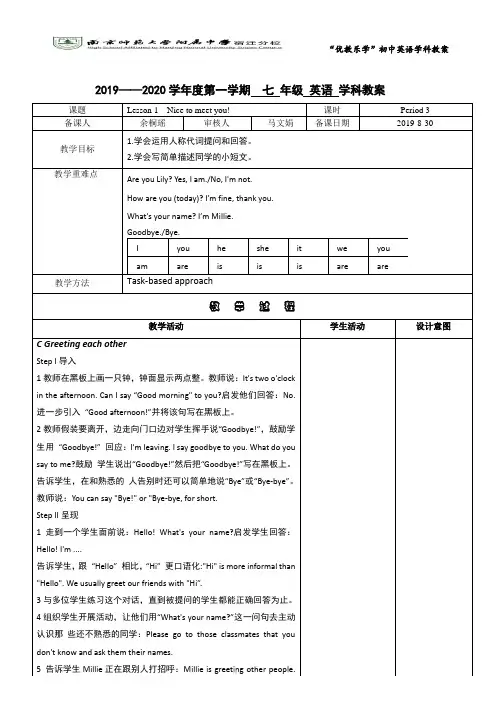
最新译林版七年级英语预备课程Lesson1 Nice to meet you!同步练习(含答案)XXX New FriendsMaking new friends XXX and fun。
It's always nice to meet new people and learn about them。
Sometimes it can be a little scary。
too。
But don't worry。
here are some tips to help youmake new friends.First。
XXX're not。
People will like you for who you are。
If you try to be someone else。
you may not be happy and you won't make real friends.Second。
be friendly。
Smile and say hello to people。
Ask them how they are doing。
Be interested in what they have to say。
Listen to them.Third。
find things you have in common。
Maybe you bothlike the same sports team or TV show。
Maybe you both like todraw or play video games。
Talk about these things and you'll have something to bond over.Fourth。
be patient。
It takes time to make good friends。
Don't get discouraged if it doesn't XXX trying and you'll find people who you really connect with.Remember。
Unit 1 This is me!Comic strip & Welcome to the unitI. Teaching aims and learning objectivesBy the end of the lesson, students should be able to:1. know the two cartoon characters, Eddie and Hobo, and the six students at Sunshine Middle School;2. greet each other properly in English;3. introduce oneself to others in English.II. Teaching contents1. New words and phrases: master, e-dog, good morning/good afternoon/good evening/good night2. New structures:What’s your name?My name is …Nice to meet you.Nice to meet you, too.III. Focus o f the lesson and predicted area of difficultyHow to introduce each other and greet each other in English.IV. Teaching proceduresComic stripStep 1 Lead-in:Enjoy the video “make friends”.T: Today we’ll learn U nit 1 This is me! Do you like the song in the video? We are now new students at Donglin Middle School, and meet many new classmates. Do you want to make more friends? I’d like you to meet two new friends in our books. Do you want to know them?【设计意图:由视频再到图片make friends引出不同人物的名字。
2019-2020年初中七年级上英语预备课程Lesson 1 Nice to meet you !牛津译林版课后练习第三十六篇➢第1题【单选题】Hello, Jim. How are ______?A、heB、sheC、ID、Mr. and Mrs. Fang【答案】:【解析】:➢第2题【单选题】—Are you Tony?—________________.A、Yes, I"m notB、Yes, I"mC、No, I amD、No, I"m not【答案】:【解析】:➢第3题【单选题】—_________— She is fine, thanks.A、What"s your mum?B、How is your mum?C、Who is your mumD、Is this your mum?【答案】:【解析】:➢第4题【单选题】Tom and he_______ happy.A、amB、isC、areD、be【答案】:【解析】:➢第5题【单选题】Peter and I ______ good friends. I ________ Chinese. Peter ________ English.A、is, am, areB、am, is, areC、is, are, amD、are, am, is【答案】:【解析】:➢第6题【单选题】—You are very clever(聪明)。
—____________A、No.B、Good.C、Yes.D、Thank you.【答案】:【解析】:➢第7题【单选题】—Hello, Tom. Nice to meet you.—___________A、What"s your name?B、How are you?C、Nice to meet you, tooD、I"m fine【答案】:【解析】:➢第8题【单选题】如果王小姐是你的老师,你应该称呼她为_________。
精选2019-2020年牛津译林版初中七年级上英语预备课程Lesson 1 Nice to meet
you !课后练习第十四篇
第1题【单选题】
—_________
— She is fine, thanks.
A、What"s your mum?
B、How is your mum?
C、Who is your mum
D、Is this your mum?
【答案】:
【解析】:
第2题【单选题】
Peter and I ______ good friends. I ________ Chinese. Peter ________ English.
A、is, am, are
B、am, is, are
C、is, are, am
D、are, am, is
【答案】:
【解析】:
第3题【单选题】
Tom and he_______ happy.
A、am
B、is
C、are
D、be
【答案】:
【解析】:
第4题【单选题】
—Are you Tony?
—________________.
A、Yes, I"m not
B、Yes, I"m
C、No, I am
D、No, I"m not
【答案】:
【解析】:
第5题【单选题】
—You are very clever(聪明)。
—____________
A、No.
B、Good.
C、Yes.
D、Thank you.
【答案】:
【解析】:
第6题【单选题】
—Hello, Tom. Nice to meet you. —___________
A、What"s your name?
B、How are you?
C、Nice to meet you, too
D、I"m fine
【答案】:
【解析】:
第7题【单选题】
Hello, Jim. How are ______?
A、he
B、she
C、I
D、Mr. and Mrs. Fang
【答案】:
【解析】:
第8题【填空题】
写出下列词语的缩写形式。
①I am______
②you are ______
③what is______
④who is ______
⑤he is______
⑥she is ______
【答案】:
【解析】:
第9题【填空题】
从A-N字母中,分别找出含有A,E读音的字母。
______ 【答案】:
【解析】:
第10题【句型转换】
My name is Lucy King. (对画线部分提问)
______ ______ name?
【答案】:
【解析】:
第11题【句型转换】
I am Martin. (改为同义句) ______ ______ is Martin. 【答案】:
【解析】:
第12题【翻译】
汉译英。
早上好______
我很好。
______
晚上好______
你叫是什么名字?______
再见______
【答案】:
【解析】:
第13题【连词成句】
下面的句子被打乱了。
你能重新将它们排列好吗?GiGi, name, my, is(.)
name, what, is, your( )
your, what, is, father( )
right, are, you, Tom(.)
teacher, my, is, this(.)
【答案】:
【解析】:
第14题【单词拼写(词汇运用)】
根据汉语写单词。
Spotty is a lovely______ (狗).
Which ______(班级) are you in?
Sally and I are good______ (朋友).
-- Are they ______ (同班同学)?
-- Yes, they are.
Yan Ming is tall and______(强壮的).
It"s seven o"clock. Let"s go to ______(学校).
Are ______(他们) eleven years old?
【答案】:
【解析】:
第15题【语法填空】
用be动词的正确形式填空。
I ______Wang Fang.
He______ Mr. Zhu?
How______ you?
What______ your name?
All my new classmates ______clever and kind.
【答案】:
【解析】:。